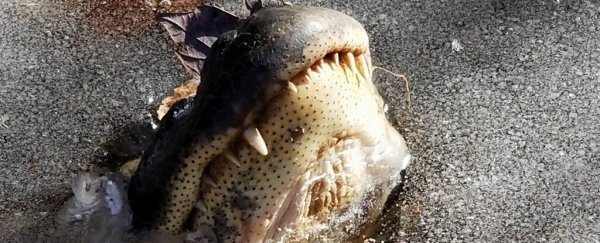The first time he saw them, on a freezing morning last January, George Howard thought the odd-shaped humps protruding from his iced-over swamp were tree stumps.
But somehow that didn't seem right. He strained his eyes. They were tree stumps with teeth?
Howard panicked. He is, after all, the manager of the Swamp Park, which features an alligator preserve in Ocean Isle Beach, N.C. What appeared to be the frozen death of his alligators would be a tragedy both philosophically and financially.
He hopped the fence and clambered onto the pond, running toward the exposed alligator snouts. But, what could he do? The alligators were locked in the ice and immobile.
"I was like, holy crap, should I try to get them out of there?" Howard told The Washington Post.
But before he launched into an impromptu ice excavation, he decided some scientific research was in order, or at least some hurried googling. Relief washed over him as the search results loaded: His alligators were alive. They were surviving in the freezing water by sticking their snouts through the ice. Howard's worry was replaced with another emotion: astonishment.
"It was the craziest thing I'd ever seen," he told The Post this week. "I was just astounded. Initially I was [worried], and then I realized what they were doing and that it was the only way they could breathe. And I thought, how intelligent is that?"
Howard thought it a once-in-a-lifetime alligator experience. Then, last week, a cold snap pierced the air throughout much of North Carolina and the northeast, freezing the water in Howard's 65-acre park near the Shallotte River.
No googling was necessary this time. Instead, Howard posted photos straight to Facebook. Customers were wowed. News outlets posted stories with the word "freaky" in their headlines. The gators remained unfazed.
Every one of the 18 alligators who live at the Swamp Park — all rescued after living in captivity — appeared to know the cold weather drill, Howard said.
When it starts getting cold, the alligators submerge most of their bodies in the shallow water, then stick their noses up in the air in anticipation of the freeze ahead, creating a little hole to breathe through.
Once the water freezes, the ice sticks to their snouts, locking the gator-cicles in place while their bodies dangle below the surface.
Howard doesn't know the origin of the behavior. In fact, no one really does.
Adam E. Rosenblatt, a biology professor at the University of North Florida who studies how alligators respond to environmental changes, said that's the big mystery.
The behavior, he said, is likely not something the alligators learned by practicing but, rather, is instinctual, something developed over time through natural selection.
"If the alligator species has been living in cold temperatures for a long enough time, then the ones who were able to do this are the ones that would be able to survive and reproduce," he said.
"How they knew how to do it? I don't think anybody knows the answer at this point."
In the late 1970s and early 1980s, Rosenblatt said, scientists began studying the behavior in detail. Because most alligators live in warm, southern climates — North Carolina is about as far north as they go — it's unusual for them to even experience extended freezing temperatures. No one except the alligators seemed too curious about how they managed to make it through the rare freezing nights.
Then in 1983, alligator ecologists noticed an entire congregation of alligators sticking their noses through the ice in North Carolina. They had heard herpetological legends of outcast alligators somehow managing to survive six straight winters in Pennsylvania or four years in Virginia.
But they knew the ice technique couldn't be new behavior. The ancestors of alligators evolved 245 million years ago. Surely, they didn't just choose a Keystone State cold snap to debut a new survival technique. It turns out scientists simply weren't paying close enough attention.
Now, they know what's going on in the ice: When the alligators go under, Rosenblatt said, they enter what's called "brumation" — like hibernation but for the coldblooded — and their bodies almost entirely shut down. All they need to do is breathe.
"They basically shut down their metabolism. They don't need to eat because they're not burning a lot of energy," Rosenblatt said.
"They slow down their heart rate, their digestive system, and they just sit there and wait out the cold weather. It's a pretty amazing adaptation."
It does not always work. One of the earliest studies of "icing" among alligators, in 1982, examined an alligator who died doing it. After three days, its body temperature became too low for survival.
And scientists in 1990, for example, watched a group of alligators in South Carolina, including baby ones and found that the baby alligators didn't know the technique, and were seen banging their snouts on the ice trying to break through before they drowned.
Three larger alligators who were late to the game survived under the ice for 12 hours before finally coming up for air and joining the others.
Once the ice melted, they all simply retreated back to shore, basking in the sun as though returning from a nap.
2019 © The Washington Post
This article was originally published by The Washington Post.
